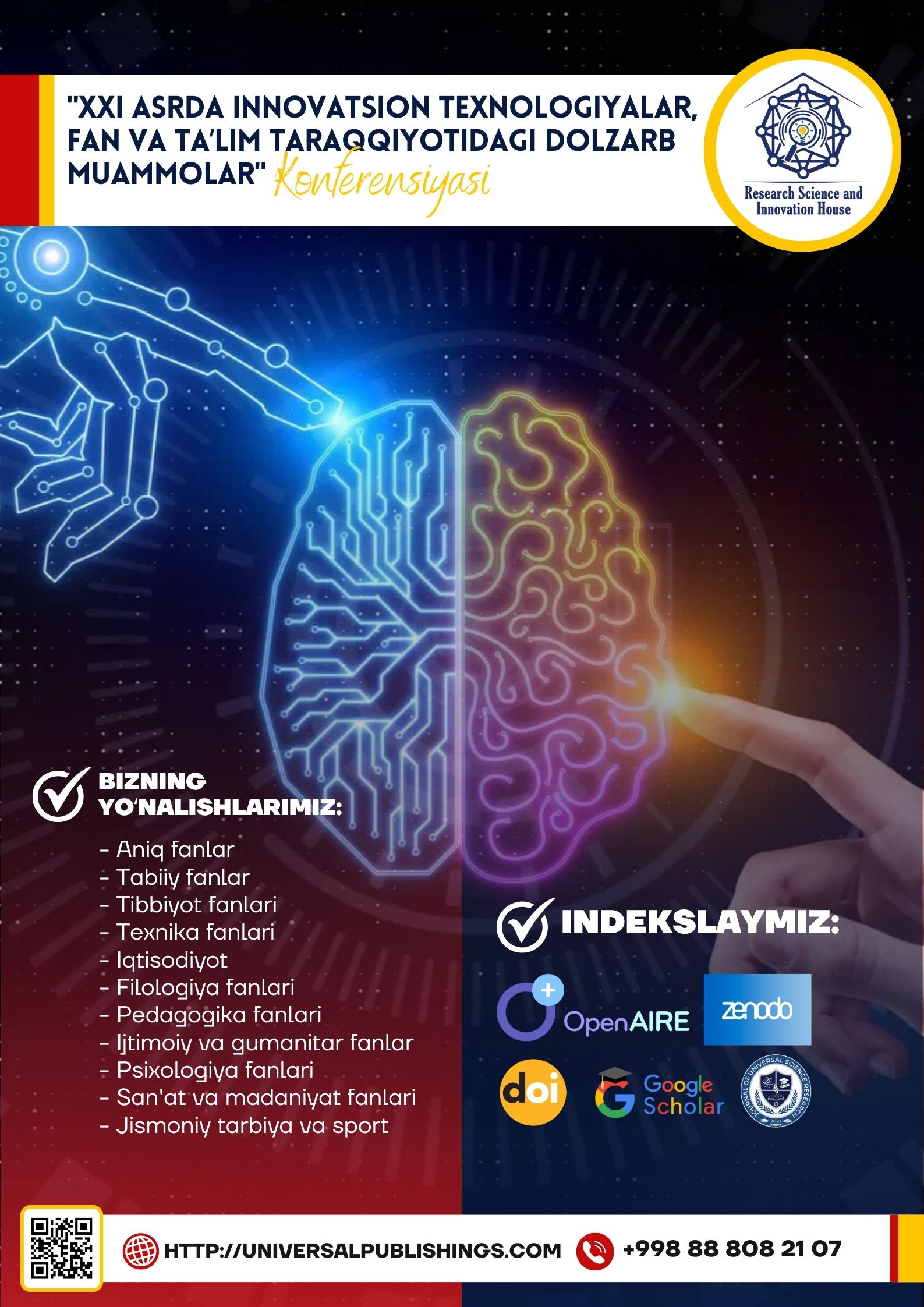Abstract
This article explores the articulatory and acoustic features that contribute to human speech production, focusing on the functions and interactions of the speech organs. The articulatory features section breaks down how different places and manners of articulation, such as bilabials, velars, stops, and fricatives, shape specific sounds. The discussion on acoustic features introduces key properties like frequency, amplitude, formants, and duration, which define the auditory characteristics of speech sounds and affect their perception. Additionally, the article details the anatomical components involved in producing speech, including the lungs, larynx, pharynx, oral and nasal cavities, tongue, teeth, and lips. Each of these speech organs contributes uniquely to articulating sounds and influencing acoustic qualities, ultimately enabling complex, varied, and nuanced human communication. The article concludes by emphasizing the importance of understanding these mechanisms for fields such as linguistics, speech therapy, and technology, highlighting how insights into the articulatory and acoustic bases of speech deepen our knowledge of language and communication. This comprehensive approach offers a foundation for studying and addressing the intricacies of human speech in both practical and theoretical contexts.
References
1. Crystal, D. (2008). A Dictionary of Linguistics and Phonetics. Wiley-Blackwell.
2. Johnson, K. (2012). Acoustic and Auditory Phonetics (3rd ed.). Wiley-Blackwell.
3. Ladefoged, P. (2001). A Course in Phonetics (4th ed.). Harcourt Brace College Publishers.
4. Ladefoged, P., & Maddieson, I. (1996). The Sounds of the World’s Languages. Blackwell Publishing.
5. Laver, J. (1994). Principles of Phonetics. Cambridge University Press.
6. Stevens, K. N. (1998). Acoustic Phonetics. MIT Press.
7. Titze, I. R. (2000). Principles of Voice Production. National Center for Voice and Speech.
8. Teshaboyeva, N., & Mamayoqubova, S. (2020). COMMUNICATIVE APPROACH TO LANGUAGE TEACHING. In МОЛОДОЙ ИССЛЕДОВАТЕЛЬ: ВЫЗОВЫ И ПЕРСПЕКТИВЫ (pp. 409-414).
9. Teshaboyeva, N. (2020). LINGUISTIC PERSONALITY, ITS STRUCTURAL CHARACTERISTICS IN THE NEW PERSPECTIVE DIRECTIONS. In МОЛОДОЙ ИССЛЕДОВАТЕЛЬ: ВЫЗОВЫ И ПЕРСПЕКТИВЫ (pp. 415-420).
10. Teshaboyeva, N. Z. (2019). TEACHING ENGLISH THROUGH LITERATURE INTESL AND TEFL CLASSROOMS. In СОВРЕМЕННЫЕ ТЕХНОЛОГИИ: АКТУАЛЬНЫЕ ВОПРОСЫ, ДОСТИЖЕНИЯ И ИННОВАЦИИ (pp. 82-84).
11. Хидирова, Д., & Тешабоева, Н. (2022). Pedagogical conditions for the development of the healthy thinking in students. Zamonaviy innovatsion tadqiqotlarning dolzarb muammolari va rivojlanish tendensiyalari: yechimlar va istiqbollar, 1(1), 120-122.
12. Gaybullayeva, N. D. K., & Kizi, T. N. Z. (2022). THE ROLE OF INNOVATIVE METHODS FOR LISTENING COMPREHENSION IN TEACHING LANGUAGE LEARNERS FOREIGN LANGUAGES AND MAINLY ENGLISH. Central Asian Research Journal for Interdisciplinary Studies (CARJIS), 2(10), 8-10.
13. Teshaboyeva Nafisa Zubaydulla qizi, Jurayev Muhammadrahim Murod o’g’li, & Mamirova Munisa Rajab qizi. (2021). Language Learning Culturally and the Role of Literature in Teaching Process. Central Asian Journal of Theoretical and Applied Science, 2(3), 1-5. Retrieved from https://www.cajotas.centralasianstudies.org/index.php/CAJOTAS/article/view/84
14. Teshaboyeva, N. (2023). THE IMPORTANCE OF TOURISM IN PRESENT DAY. Журнал иностранных языков и лингвистики, 5(5).
15. Teshaboyeva, N. (2023). THE MODERN INNOVATIVE TECHNOLOGIES IN TEACHING FOREIGN LANGUAGES. Журнал иностранных языков и лингвистики, 5(5).
16. Teshaboyeva, N. Z. (2023, November). Adjective word group and its types. In " Conference on Universal Science Research 2023" (Vol. 1, No. 11, pp. 59-61).
17. Teshaboyeva, N. Z. (2023, November). Modifications of Consonants in Connected speech. In " Conference on Universal Science Research 2023" (Vol. 1, No. 11, pp. 7-9).
18. Teshaboyeva, N., & Rayimberdiyev, S. (2023, May). THE IMPORTANCE OF USING MULTIMEDIA TECHNOLOGY IN TEACHING ENGLISH CLASSES. In Academic International Conference on Multi-Disciplinary Studies and Education (Vol. 1, No. 8, pp. 149-153).
19. Nafisa, T., & Marina, S. (2023). TEACHING AND LEARNING OF ENGLISH VOCABULARY IN TESL AND TEFL CLASSROOMS. International Journal of Contemporary Scientific and Technical Research, 465-469.
20. Ibrohimovna, X. M. (2023). The Importance of Methods in Language Teaching Process. Web of Scholars: Multidimensional Research Journal, 2(1), 20-23.
21. Тешабоева, Н. (2023). Teaching writing as a major part of productive skills in mixed ability classes . Информатика и инженерные технологии, 1(2), 652–656. извлечено от https://inlibrary.uz/index.php/computer-engineering/article/view/25759
22. Teshaboyeva Nafisa Zubaydulla kizi, & Akramov Ibrohimjon. (2023). WORD FORMATION. COMPOUNDING. "XXI ASRDA INNOVATSION TEXNOLOGIYALAR, FAN VA TAʼLIM TARAQQIYOTIDAGI DOLZARB MUAMMOLAR" Nomli Respublika Ilmiy-Amaliy Konferensiyasi, 1(12), 109–113. Retrieved from https://universalpublishings.com/index.php/itfttdm/article/view/3187
23. Teshaboyeva, N., & Yakubova, N. (2023). CHANGES OF MEANING OF WORDS. Центральноазиатский журнал образования и инноваций, 2(12), 126-129.
24. Sharifova Dinora Tohir qizi, & Teshaboyeva Nafisa. (2023). “ NOUNS AND THEIR GRAMMATICAL CATEGORIES”. Новости образования: исследование в XXI веке, 2(16), 292–297. извлечено от http://nauchniyimpuls.ru/index.php/noiv/article/view/13128
25. Teshaboyeva Nafisa Zubaydulla kizi, & Akramov Ibrohimjon. (2023). WORD FORMATION. COMPOUNDING. "XXI ASRDA INNOVATSION TEXNOLOGIYALAR, FAN VA TAʼLIM TARAQQIYOTIDAGI DOLZARB MUAMMOLAR" Nomli Respublika Ilmiy-Amaliy Konferensiyasi, 1(12), 109–113. Retrieved from https://universalpublishings.com/index.php/itfttdm/article/view/3187
26. Qodirova Aziza Yunusovna, & Teshaboyeva Nafisa Zubaydulla qizi. (2023). “VERBS AND THEIR GRAMMATICAL CATEGORIES”. Новости образования: исследование в XXI веке, 2(16), 280–283. извлечено от http://nauchniyimpuls.ru/index.php/noiv/article/view/13126
27. Tuxtayeva Aziza Ilhom qizi, & Teshaboyeva Nafisa. (2023). Word Formation: Compounding . "Conference on Universal Science Research 2023", 1(12), 113–115. Retrieved from https://universalpublishings.com/index.php/cusr/article/view/3185
28. Teshaboyeva Nafisa Zubaydulla, & Iskandarova Sarvinoz Shukurullo qizi. (2023). THE CLASSIFICATION OF SYNONYMS AND THEIR SPECIFIC FEATURES. "XXI ASRDA INNOVATSION TEXNOLOGIYALAR, FAN VA TAʼLIM TARAQQIYOTIDAGI DOLZARB MUAMMOLAR" Nomli Respublika Ilmiy-Amaliy Konferensiyasi, 1(12), 126–131. Retrieved from https://universalpublishings.com/index.php/itfttdm/article/view/3191
29. Тешабоева, Н. (2023). Teaching writing as a major part of productive skills in mixed ability classes . Информатика и инженерные технологии, 1(2), 652–656. извлечено от https://inlibrary.uz/index.php/computer-engineering/article/view/25759

